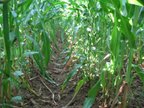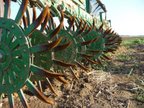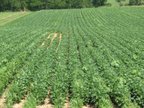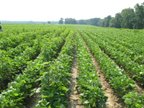Out-of-State Organic Grain Bus Tour: Recap
go.ncsu.edu/readext?277179
en Español / em Português
El inglés es el idioma de control de esta página. En la medida en que haya algún conflicto entre la traducción al inglés y la traducción, el inglés prevalece.
Al hacer clic en el enlace de traducción se activa un servicio de traducción gratuito para convertir la página al español. Al igual que con cualquier traducción por Internet, la conversión no es sensible al contexto y puede que no traduzca el texto en su significado original. NC State Extension no garantiza la exactitud del texto traducido. Por favor, tenga en cuenta que algunas aplicaciones y/o servicios pueden no funcionar como se espera cuando se traducen.
Português
Inglês é o idioma de controle desta página. Na medida que haja algum conflito entre o texto original em Inglês e a tradução, o Inglês prevalece.
Ao clicar no link de tradução, um serviço gratuito de tradução será ativado para converter a página para o Português. Como em qualquer tradução pela internet, a conversão não é sensivel ao contexto e pode não ocorrer a tradução para o significado orginal. O serviço de Extensão da Carolina do Norte (NC State Extension) não garante a exatidão do texto traduzido. Por favor, observe que algumas funções ou serviços podem não funcionar como esperado após a tradução.
English
English is the controlling language of this page. To the extent there is any conflict between the English text and the translation, English controls.
Clicking on the translation link activates a free translation service to convert the page to Spanish. As with any Internet translation, the conversion is not context-sensitive and may not translate the text to its original meaning. NC State Extension does not guarantee the accuracy of the translated text. Please note that some applications and/or services may not function as expected when translated.
Collapse ▲July 24-26, 2008
By: Molly Hamilton, Chris Reberg-Horton, George Place and Adam Smith
Forty farmers, land owners, NCSU Extension and Natural Resource Conservation Service specialists, and crop consultants toured four farms in three days. We visited two organic grain farms (split operations) in Maryland, the Rodale Institute in Pennsylvania, and an organic grain farm (split operation) in Virginia.
Thursday, July 24, 2008
Mason’s Heritage Farm– Bill Mason (Queen Anne, Maryland)
 Bill Mason farms 200 acres in organic grain production and 400 in conventional grain production. When we first arrived, Bill gave us an overview of his farming operations at his farm stand by his house. His two year organic rotation is corn – rye – soybeans – clover. The rye is rolled down and soybeans are no-till planted into the rolled down rye, though the acreage in clover is moldboard plowed prior to planting corn. Bill said his is considering going to a longer rotation which may include barley and/or red clover (not grown as a double crop).
Bill Mason farms 200 acres in organic grain production and 400 in conventional grain production. When we first arrived, Bill gave us an overview of his farming operations at his farm stand by his house. His two year organic rotation is corn – rye – soybeans – clover. The rye is rolled down and soybeans are no-till planted into the rolled down rye, though the acreage in clover is moldboard plowed prior to planting corn. Bill said his is considering going to a longer rotation which may include barley and/or red clover (not grown as a double crop).
Fertility is sometimes a challenge at this farm due to the phosphorous build up restrictions in the Chesapeake Bay watershed. Chicken litter used continuously leads to high soil phosphorous levels. Bill uses crimson clover as a cover crop before corn to get some plant-based N for the heavy feeding crop. The crimson clover cover crop contributes 60-110 lb N/acre. He uses some chicken litter (4 tons/acre), but tries to limit the use. He does use Purdue’s pelletized chicken litter (4:2:3 analysis) at about 2 tons/acre. The pelletized litter is expensive at $80/ton, but spreads evenly and contributes less P than fresh litter. Bill also spreads about 1 ton of lime per acre every 3 years.
After listening to Bill describe his farm and fertility practices, we boarded the bus to drive to the back of the farm to see some of his acreage. The tour bus got stuck soon after venturing on the sandy farm roads and Bill had to pull us out with his tractor.




The main soil type on this farm is Sassafras sandy loam. Some hardpan problems have arisen at about 9 inches depth which Bill remediated with some ripping. organic corn and 50 bu/acre of organic full-season soybeans. His conventional soybeans follow wheat, they average 40-50 bu/acre. Irrigated conventional corn on this farm yields about 200 bu/acre. The soybeans are MG 3.4 and are planted to get a target population of 200,000 plants/acre. The rye cover crop is rolled down and soybeans are no-till planted into the rolled down rye. Bill has been drilling his soy in the rolled-down rye with good results—average 55 bu/acre soybeans.  To roll down the rye, he uses a 15 foot, front-mounted roller which weighs about 3000 lbs when filled with water (125 gallons). Bill does not employ any additional weed control techniques. The soybeans are harvested in mid October. Crimson clover is planted right behind the combine. Often, rye residue remains up to the soybean harvest, and Bill is considering tilling in some rye to get a better clover stand. Organic corn is planted 2nd week of May and also harvested in mid October. Bill planted experimental plots this year (with help from the Rodale Institute and researchers from USDA-ARS) looking at rolling a legume cover crop and no-till planting organic corn. However, he got sparse stands of crimson clover and Austrian winter peas which were not effective in smothering germinating weeds in the corn–see picture, right. He is interested in trying hairy vetch because of good results that the Rodale Institute has had, but is wary of using it because he does not want it to become a weed on the farm. Currently, he is still moldboard plowing the crimson clover before planting corn. Bill feels this also helps with weed control in the corn.
To roll down the rye, he uses a 15 foot, front-mounted roller which weighs about 3000 lbs when filled with water (125 gallons). Bill does not employ any additional weed control techniques. The soybeans are harvested in mid October. Crimson clover is planted right behind the combine. Often, rye residue remains up to the soybean harvest, and Bill is considering tilling in some rye to get a better clover stand. Organic corn is planted 2nd week of May and also harvested in mid October. Bill planted experimental plots this year (with help from the Rodale Institute and researchers from USDA-ARS) looking at rolling a legume cover crop and no-till planting organic corn. However, he got sparse stands of crimson clover and Austrian winter peas which were not effective in smothering germinating weeds in the corn–see picture, right. He is interested in trying hairy vetch because of good results that the Rodale Institute has had, but is wary of using it because he does not want it to become a weed on the farm. Currently, he is still moldboard plowing the crimson clover before planting corn. Bill feels this also helps with weed control in the corn.
Fairhill Farms – Ed Fry ( Chestertown, MD)
 Ed Fry has been farming since the 1960’s, and currently has 400 acres in organic production, 300 in transition to organic, and 200 acres in conventional production. His son milks 260 conventional dairy cows on the farm. Ed’s rotation is generally corn – small grain (wheat or triticale) – soybean – alfalfa (3 years). Sometimes an annual legume cover crop is substituted for alfalfa.
Ed Fry has been farming since the 1960’s, and currently has 400 acres in organic production, 300 in transition to organic, and 200 acres in conventional production. His son milks 260 conventional dairy cows on the farm. Ed’s rotation is generally corn – small grain (wheat or triticale) – soybean – alfalfa (3 years). Sometimes an annual legume cover crop is substituted for alfalfa.
 Crop Management: Ed normally plants his conventional corn 3 weeks before his organic corn to avoid cross pollination. This year, due to poor crimson clover stands, he planted the organic corn early (early April). He applied dairy manure to the corn and rotary hoed and cultivated it twice, and the corn looked very clean. He considers the weed control a $321/acre investment (based on custom rates). He spends $376/acre for fertility and seed in conventional corn (he chooses his conventional acreage where he doesn’t want to cultivate due to land anomalies). He spends $132/acre on fertility for his organic corn. Ed does pre-sidedress nitrate tests (done at 12 to 16 inch height) to decide his nitrogen plan for the year. His corn populations are 29,000 – 31,500 plants/acre.
Crop Management: Ed normally plants his conventional corn 3 weeks before his organic corn to avoid cross pollination. This year, due to poor crimson clover stands, he planted the organic corn early (early April). He applied dairy manure to the corn and rotary hoed and cultivated it twice, and the corn looked very clean. He considers the weed control a $321/acre investment (based on custom rates). He spends $376/acre for fertility and seed in conventional corn (he chooses his conventional acreage where he doesn’t want to cultivate due to land anomalies). He spends $132/acre on fertility for his organic corn. Ed does pre-sidedress nitrate tests (done at 12 to 16 inch height) to decide his nitrogen plan for the year. His corn populations are 29,000 – 31,500 plants/acre.
 Ed planted soybeans on July 18 following triticale which was harvested for seed (54 bu/acre and he sold the straw as well). He plants MG 3.4. He rotary hoed these beans 1 time and cultivated 3 times. His soybean populations are 204,000 plants/acre.
Ed planted soybeans on July 18 following triticale which was harvested for seed (54 bu/acre and he sold the straw as well). He plants MG 3.4. He rotary hoed these beans 1 time and cultivated 3 times. His soybean populations are 204,000 plants/acre.
Ed grows alfalfa especially where he is getting a build up of soil phosphorous, as alfalfa takes up a lot of P. They cut alfalfa 5 time per year for three years. This averages 7 tons/acre/year with irrigation and 5 tons without irrigation. Organic alfalfa sells for $0.14/lb of dry matter.
Ed applies potash every 3 years. He also applies chicken litter to corn acreage and calculates the cost to be $6/ton to buy, $6/ton to haul and $6/ton to apply. He prefers broiler chicken because it is lower in P than layer litter.
Currently most acreage is conventionally tilled. He has experimented with no-till organic, but it has been problematic on his farm.
US Department of Agriculture – Agricultural Research Service
Drs. John Teasdale, Michel Cavigelli, and Steven Mirksy from the Sustainable Agricultural Systems Laboratory presented data from their Farming Systems Project. They have a long-term experiment comparing organic systems to conventional no-till and chisel-till systems. Three organic rotations are compared:
- Two year rotation with corn, rye, soybean and hairy vetch
- Three year rotation with corn, rye, soybean, wheat and hairy vetch
- Six year rotation with corn, rye, soybean, wheat and alfalfa
Interestingly, their comments echoed comments we heard from Ed Fry earlier in the day. Having perennials in the system benefits both weed control and nutrient management in the annual crops. Dr. Teasdale explained the benefit of perennials for weed control. Most annual weed seeds have a short persistence in the soil. Pigweed seeds, considered the most troublesome weed by many organic farmers, are reduced by half every year they remain in the soil. Previous research had suggested much longer life spans, but more recent studies have highlighted how short lived many seeds are. Yields reflected a similar pattern with greater yields in the organic systems with longer rotations. In addition to improved weed control, perennial legumes are able to contribute significantly to the nitrogen demands of subsequent annual crops. Unlike manures, they add nitrogen to the system without contributing to a buildup in soil phosphorous.
Friday, July 25, 2008
The Rodale Institute ( Kutztown, PA)
 The tour here started with introductory lectures on the history, philosophy, and current research of the Rodale Institute. The main Rodale farm is 330 acres of non-irrigated crop land (except for some small acreage of vegetables). Their long-term systems crop experiment started in 1981 and looks at 3 main systems, with each of these systems now divided into no-till and tilled (for a total of 6 systems):
The tour here started with introductory lectures on the history, philosophy, and current research of the Rodale Institute. The main Rodale farm is 330 acres of non-irrigated crop land (except for some small acreage of vegetables). Their long-term systems crop experiment started in 1981 and looks at 3 main systems, with each of these systems now divided into no-till and tilled (for a total of 6 systems):
- livestock based, organic manure application in a corn-soy-wheat-hay rotation with hairy vetch and rye cover crops,
- non-livestock based organic system with no manure, corn-soy-wheat with legume cover crops,
- conventional production with corn –soy – wheat rotation (uses the chemical recommendations from Penn State).
Regenerative farming is Rodale’s term for organic production with heavy reliance upon soil building with cover crops. They pointed out that every lb of carbon in the soil can hold 40 lbs of water. Cover crops can add 1000 lbs of carbon/acre, thus 5000 gallons of water.
 Dave Wilson, the research agronomist at Rodale, talked quite a bit about their work with planting no-till organic grains into rolled down cover crops. Their main 3 year rotation is wheat-vetch-corn-rye-soy. The idea is that the vetch and rye cover crops can be roll-killed with their front tractor mounted roller and the corn or soybeans no-till planted or drilled into the rolled down cover crop. The roll-killed cover crop acts as a mulch, suppressing weed seed germination (see image right). However, the vetch is often plowed in to kill the weeds, because continuous no till is nearly impossible in organics due to weeds. Dave Wilson talks of rotational no-till in organic production—using no-till in certain crops or over 1 or 2 years and rotating in a crop that will be tilled and cultivated. Tillage is the big hammer in organic weed management – it’s hard to give it up.
Dave Wilson, the research agronomist at Rodale, talked quite a bit about their work with planting no-till organic grains into rolled down cover crops. Their main 3 year rotation is wheat-vetch-corn-rye-soy. The idea is that the vetch and rye cover crops can be roll-killed with their front tractor mounted roller and the corn or soybeans no-till planted or drilled into the rolled down cover crop. The roll-killed cover crop acts as a mulch, suppressing weed seed germination (see image right). However, the vetch is often plowed in to kill the weeds, because continuous no till is nearly impossible in organics due to weeds. Dave Wilson talks of rotational no-till in organic production—using no-till in certain crops or over 1 or 2 years and rotating in a crop that will be tilled and cultivated. Tillage is the big hammer in organic weed management – it’s hard to give it up.
Dave and Jeff Moyer, the farm manager, gave us some tips on cover crop management. They plantvetch at 28lbs seed/acre at 3 rd week of Aug or Sept 1 st. In their area of PA, vetch needs 4 inches of top growth before the winter but not much more. Earlier planting may result in more top growth which tends to be laid down more by winter snow – once laid down by snow it really doesn’t stand up in the spring. Jeff Moyer suggested making sure that your cover crop seed is produced in an equivalent region to where you will plant it. Cover crop seed from different regions or climates may cause problems on your farm. Dave Wilson also said they can produce up to 2000 lbs of dry weed biomass in their corn and still have comparable yields to the conventional corn. In other words, the organic corn can compete well with a lot of weeds and still have yields similar to their conventional corn. Dave Wilson also discussed the timing of the vetch: earlier blooming vetch  with 90 day corn was good to be able to get corn dried down before harvest (big money savings vs. drying down after harvest). They had a wire worm challenge that was dependent on planting timing and was variable from year to year. One year the earliest corn was damaged by the wire worm. In a different year the 2 nd and 3 rd planting date was wire worm damaged. The late corn planting avoided wire worm but would have the dry down challenge.
with 90 day corn was good to be able to get corn dried down before harvest (big money savings vs. drying down after harvest). They had a wire worm challenge that was dependent on planting timing and was variable from year to year. One year the earliest corn was damaged by the wire worm. In a different year the 2 nd and 3 rd planting date was wire worm damaged. The late corn planting avoided wire worm but would have the dry down challenge.
Saturday, July 26, 2008
Hillsborough Farm – Todd Henley (farmer), Chris Lawrence (NRCS) gave tour ( Walkerton, VA)
Chris Lawrence, of Virginia’s office of Natural Resource Conservation Service (NRCS), led the tour of Todd Henley’s farm. The county Extension agent, Keith Balderson, and two of Todd’s sons were also present and helped answer questions. The farm is 1000 acres (600 rented, 400 owned), with 400 in organic production. The organic land has been certified for at least 12 years. The two year rotation is corn followed by a rye cover crop – soybeans followed by crimson clover cover crop (seeded by airplane). Todd also raises a small herd of beef cattle on the side.
 We started the tour in the side yard of the Henley’s house, a large antebellum home right on the Mattaponi River—a beautiful setting. Chris quickly brought up the fact that this farm has two major problems that are threatening the continuation of organic production on the farm: fertility and weeds. Todd applies 2-3 tons of chicken litter to his corn crop. This is not really adequate to get good yields with organic production as 1 ton of chicken litter give about 30 lbs of N, and corn needs about 1 lb N/acre for every bushel produced. Todd is worried that applying more chicken litter will raise his soil phosphorous to environmentally detrimental levels. He is active in his county’s soil and water conservation district and lives in the Chesapeake Bay watershed where phosphorous runoff is a concern. The low N levels, however, are keeping his corn yields around 75 bushel/acre (conventional on same farm is 150-200 bu/acre), even with irrigation. These low yields are discouraging for Todd. Chris and the county Extension agent did some research plots to see what yields would be if more chicken litter was applied. They found that yields on the farm did increase with more litter.
We started the tour in the side yard of the Henley’s house, a large antebellum home right on the Mattaponi River—a beautiful setting. Chris quickly brought up the fact that this farm has two major problems that are threatening the continuation of organic production on the farm: fertility and weeds. Todd applies 2-3 tons of chicken litter to his corn crop. This is not really adequate to get good yields with organic production as 1 ton of chicken litter give about 30 lbs of N, and corn needs about 1 lb N/acre for every bushel produced. Todd is worried that applying more chicken litter will raise his soil phosphorous to environmentally detrimental levels. He is active in his county’s soil and water conservation district and lives in the Chesapeake Bay watershed where phosphorous runoff is a concern. The low N levels, however, are keeping his corn yields around 75 bushel/acre (conventional on same farm is 150-200 bu/acre), even with irrigation. These low yields are discouraging for Todd. Chris and the county Extension agent did some research plots to see what yields would be if more chicken litter was applied. They found that yields on the farm did increase with more litter.
The other major problem on this farm is weed control. Todd is very discouraged by the weed problem that has built up on the organic farm over the 18 years he has been practicing organic production. The weeds are contributing to lower yields, take a lot of work to cultivate, and every year increase the weed seed bank. He cultivates soybeans once with a rotary hoe and then 2-3 times with a cultivator. Todd is considering hand-weeding the soybeans if it is economically viable (they are testing hand-weeded soybean yields this year). He has experimented with no-tilling soybeans into a rolled down rye cover crop. It worked fairly well the first year or two, but has not been greatly successful. Part of the problem is that there is not enough N in the soil to get a good, thick stand of rye, since no fertility sources are applied to the rye cover crop. Todd uses a Buffalo high residue cultivator to cultivate the soybeans under the no-till rye residue. This year he is experimenting with hand weeding some plots of soybeans to determine what the effect is on yield and how economical it may be.
It worked fairly well the first year or two, but has not been greatly successful. Part of the problem is that there is not enough N in the soil to get a good, thick stand of rye, since no fertility sources are applied to the rye cover crop. Todd uses a Buffalo high residue cultivator to cultivate the soybeans under the no-till rye residue. This year he is experimenting with hand weeding some plots of soybeans to determine what the effect is on yield and how economical it may be.
Todd Henley is considering getting out of organic production due to the fertility and weed problems he currently faces. Chris Lawrence had some main points for consideration for organic grain farmers after the farm tour:
- consider a longer rotation than corn-soybeans
- you need some organic philosophy before getting into organic production (this will help with successful farm-scale and long-term production planning)
- use enough litter to get decent yields (don’t under-apply fertility sources so that your yields dramatically suffer)


